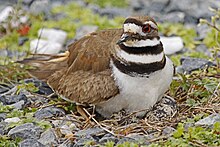Charadrius is a genus of plovers, a group of wading birds. The genus name Charadrius is a Late Latin word for a yellowish bird mentioned in the fourth-century Vulgate. They are found throughout the world.
| Charadrius | |
|---|---|

| |
| Killdeer (Charadrius vociferus) | |
| Scientific classification | |
| Domain: | Eukaryota |
| Kingdom: | Animalia |
| Phylum: | Chordata |
| Class: | Aves |
| Order: | Charadriiformes |
| Family: | Charadriidae |
| Subfamily: | Charadriinae |
| Genus: | Charadrius Linnaeus, 1758 |
| Type species | |
| Charadrius hiaticula (common ringed plover) Linnaeus, 1758 | |
| Species | |
|
See text | |
| Synonyms | |
Many Charadrius species are characterised by breast bands or collars. These can be (in the adult) single complete bands (ringed, semipalmated, little ringed, long-billed),or double or triple bands (killdeer, three-banded, Forbes').
They have relatively short bills and feed mainly on insects, worms or other invertebrates, depending on habitat, which are obtained by a run-and-pause technique, rather than the steady probing of some other wader groups. They hunt by sight, rather than by feel as do longer-billed waders like snipe.
Species of the genera Aegialites (orAegialitis), Thinornis, and Elseyornis are now subsumed within Charadrius. The former genus name Thinornis combined the Ancient Greek this meaning "beach" or "sand" with ornis meaning "bird".[1]
The genus Charadrius was introduced in 1758 by the Swedish naturalist Carl Linnaeus in the tenth edition of his Systema Naturae.[2] The name had been used (asCharadrios sive Hiaticula) by the Italian naturalist Ulisse Aldrovandi in 1603 for the common ringed plover.[3] The word is Late Latin and is mentioned in the Vulgate Bible. It derives from the Ancient Greek χαραδριος/kharadrios, an unidentified plain-coloured nocturnal bird that was found in ravines and river valleys (from kharadra, "ravine").[a][5] The type species is the common ringed plover.[6] However, it once appeared that the taxonomy of “Charadrius” was erroneous, as for example the Kentish plover is more closely related to lapwings than it is to, say, the greater ringed plover. Hence, either all members of Charadriidae, excluding Pluvialis are grouped in a single genus, Charadrius, or the genus is reduced to the Common ringed plover, Piping plover, Semipalmated plover, and Killdeer.[7] The latter option was chosen.
The genus originally contained 33 species. However, in December 2023, The International Ornithologists' Union incorporated all species under Thinornis and Elseyornis into Charadrius, and some species of Charadrius are now placed in the genus Anarhynchus. As a result, Charadrius now consists of only 11 species:[8]
Another species, the Auckland Islands shore plover (Charadrius (Thinornis) rossii), known from just one specimen collected in 1840, is now generally considered to be a juvenile shore plover whose location was incorrectly recorded.[9]